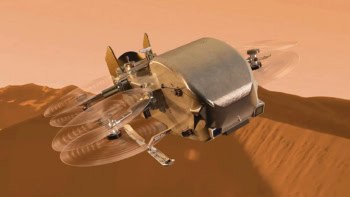Planetary scientists have developed a theory that can explain three outstanding puzzles about our solar system: Why do the giant planets have eccentric and tilted orbits? How did Jupiter get its Trojan asteroids? And what caused the Late Heavy Bombardment some 700 million years after the Earth and Moon were formed? The answer seems to be that all three phenomena seem to be a direct result of Saturn and Jupiter shifting their orbits in the early solar system.

Analysis of samples from the Moon show that lunar craters were created some 700 million years later after the Moon was formed. This implies that there was a huge increase in the rate of bombardment on the Moon at this time, although the causes of this have remained a mystery. Now, Alessandro Morbidelli and Kleomenis Tsiganis of the Observatoire de la Côte d’Azur in France, Hal Levison of the Southwest Research Institute in Boulder, Colorado, and Rodney Gomes of the National Observatory in Brazil have proposed a new model based on numerical simulations that solves this enigma and the other two puzzles as well (Nature 435 459, 462 and 466).
The model shows that Saturn and Jupiter may have shifted their orbits early on in the history of solar system, with Saturn moving slightly away from the Sun, and Jupiter moving slightly towards it. The planets could have been moved by the gravitational effects of thousands of “planetesimals” that lay in a disk outside the orbit of Neptune. A planetesimal is a small object made of rock and ice that was left over when the planets formed.
Levison and colleagues argue that, 700 million years later, this resulted in Saturn having an orbital period that was exactly twice that of Jupiter. In other words, Saturn was completing one orbit of the Sun for every two orbits of Jupiter. When this happened, the resulting gravitational resonance resulted in both planets elongating and tilting their orbits. In turn, this pushed the other two giant planets, Uranus and Neptune, further away from the Sun.
Moreover, as Uranus and Neptune entered the planetesimal disk, they ejected the tiny rocky objects across the solar system, causing the Late Heavy Bombardment. The model can also account for the orbital distribution of the Trojans around Jupiter and their total mass.
“This kind of work is like being a detective,” says Levison. “A detective goes to the location of a crime, sees a dead body, blood spots, a footprint and tries to deduce what happened. We are in the same situation. We have many clues -: the basins on the Moon, the orbits of the planets, the orbital structure of the small bodies — and we have to deduce how the solar system formed and evolved.”
Unlike a detective, however, Levison says that planetary scientists can never be 100% sure that their theory is right. “The validity of the model is measured from the number of observables that it is capable of reproducing, the predictions that it can make that are later confirmed, and the absence of conflict with existing constraints,” he says. “From this point of view, our model is very solid. Indeed, it kills many birds — the Late Heavy Bombardment, the detailed orbits of the giant planets and the origin of the Trojans — with one stone.”



